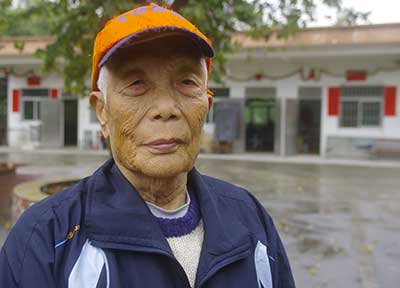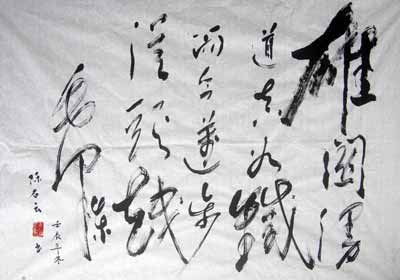


|
Shiyun Chen was born in 1926 in Jiangmen, Guangdong. He was the former captain of the art troupe of the Yaxi leprosy village and he still lives in the village. He taught himself Chinese calligraphy when he was 70 years old. Excellent at the cursive hand (caoshu) and the seal script (zhuanshu), he also created a new way to paint by blowing on colors on flat glass. --- Personal Experience: “Those Who Have A Big Heart, Have a Clear Conscience” Shiyun Chen was affected by leprosy when he was just twelve years old. Until he was twenty-two, he was still able to make a living by doing a little business. Chen taught himself Chinese calligraphy at age seventy. Since he could not afford brushes and paper, he picked up some sticks of fan palm, with a touch of water, to serve as brush, practicing writing on the ground. Since he can only hold the “brush” like a bloom due to the disability in his hand, people who are not familiar with him would not believe that he can create such beautiful, freely flowing calligraphy. Even his brother, at the beginning of Chen’s practice, laughed at him saying he would never write well. But Chen, with his industriousness and never-give-up attitude, finally proved himself. Chen started teaching himself calligraphy with the copybook of Wang Xizhi, the famous Chinese calligrapher back in the Jin Dynasty (AD 265-420). He worked hard for more than a week to practice Wang’sモタ (which means forever), a seemingly simple character. This character combines the basic strokes of dot, horizontal, vertical, falling and rising. If you can write モタcorrectly, you have made a good start in calligraphy. Later, Chen learned from the copybook of Mao Zedong. Chairman Mao is also famous for his unique style and masterful skill in calligraphy. Chen did not know how to write Mao’s signature, and after long and hard practice, he found that it is crucial to write the three characters in one single very quick stroke. Chen now enjoys writing the cursive hand (caoshu) and the seal script (zhuanshu). The seal script, one of the most important and most archaic script styles in Chinese calligraphy, preserves most of the characteristics of hieroglyphics. To Chen, the seal script is among the least familiar, even to the Chinese, but it has greater aesthetical value. One Chinese proverb that says “Those who have a big heart, have a clear conscience”, can be seen quite often in his work. Chen also takes it as his motto in the sunset of his life. Chen also paints when he is inspired. The disability in his hand, however, makes it very difficult for him to control some very fine strokes. Chen invented, by accident, a painting technique to overcome this. It happened at sunset, when Chen tried to capture the flowing evening clouds in the sky. An idea struck him and he then found a flat glass, poured colors on the glass and blew on the colors to get the right shapes of a cloud. He then put some paper on it and pressed softly. He got the result that he wanted. He wrote the line of a famous Chinese poem on the painting: “Sunset is perfect except that it disappears”, which according to Chen, is a picture of his life. Anhua Chen, another Chinese-painting-lover in the village, became friends with Shiyun Chen. They talk over a pot of hot tea from time to time. They also work together. When one has a painting done, the other writes something for the work. The two art-lovers met each other and built a deep friendship because of their shared destinies and hobbies. With his breadth of character and peace of mind, Chen has found a place of his own. --- Note: By blowing on colors on flat glass, colors flow and gradually form some unexpected yet natural shapes of clouds. After the shapes satisfy the artist, then press a piece of paper on them and get printed images of clouds. Source: HANDA Rehabilitation and Welfare Association, The Beauty of the Spirit, (Guangzhou, 2014) |








